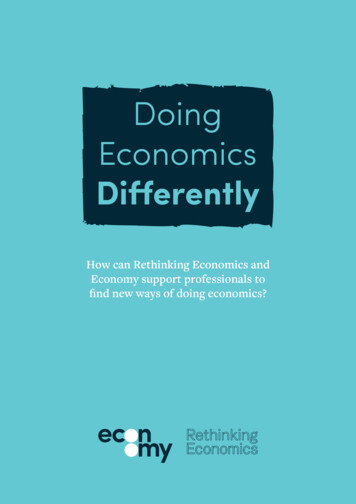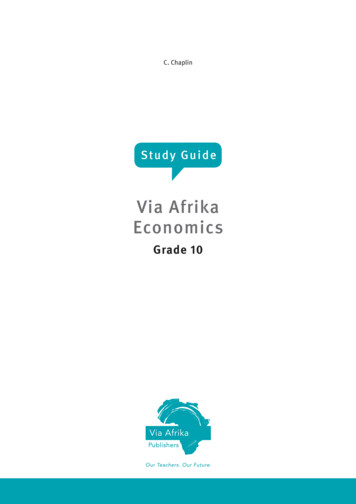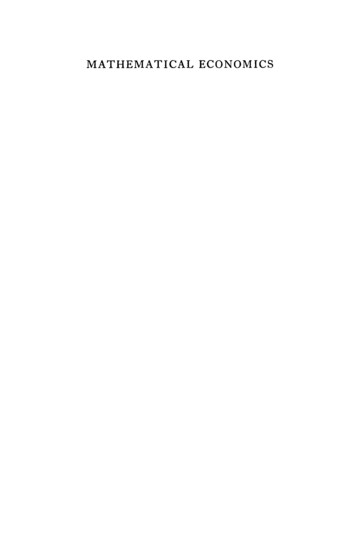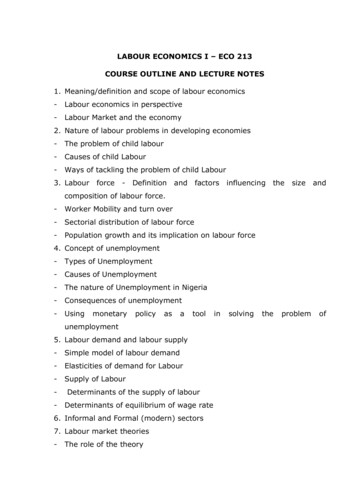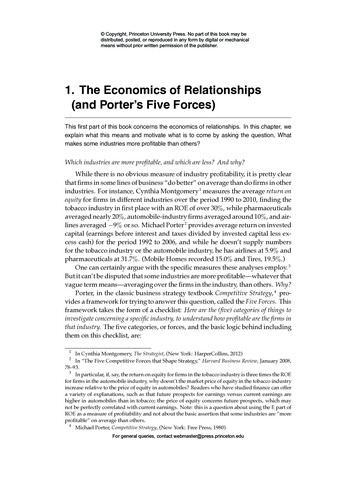
Transcription
Copyright, Princeton University Press. No part of this book may bedistributed, posted, or reproduced in any form by digital or mechanicalmeans without prior written permission of the publisher.1. The Economics of Relationships(and Porter’s Five Forces)This first part of this book concerns the economics of relationships. In this chapter, weexplain what this means and motivate what is to come by asking the question, Whatmakes some industries more profitable than others?Which industries are more profitable, and which are less? And why?While there is no obvious measure of industry profitability, it is pretty clearthat firms in some lines of business “do better” on average than do firms in otherindustries. For instance, Cynthia Montgomery 1 measures the average return onequity for firms in different industries over the period 1990 to 2010, finding thetobacco industry in first place with an ROE of over 30%, while pharmaceuticalsaveraged nearly 20%, automobile-industry firms averaged around 10%, and airlines averaged 9% or so. Michael Porter 2 provides average return on investedcapital (earnings before interest and taxes divided by invested capital less excess cash) for the period 1992 to 2006, and while he doesn’t supply numbersfor the tobacco industry or the automobile industry, he has airlines at 5.9% andpharmaceuticals at 31.7%. (Mobile Homes recorded 15.0% and Tires, 19.5%.)One can certainly argue with the specific measures these analyses employ. 3But it can’t be disputed that some industries are more profitable—whatever thatvague term means—averaging over the firms in the industry, than others. Why?Porter, in the classic business strategy textbook Competitive Strategy, 4 provides a framework for trying to answer this question, called the Five Forces. Thisframework takes the form of a checklist: Here are the (five) categories of things toinvestigate concerning a specific industry, to understand how profitable are the firms inthat industry. The five categories, or forces, and the basic logic behind includingthem on this checklist, are:1In Cynthia Montgomery, The Strategist, (New York: HarperCollins, 2012)In “The Five Competitive Forces that Shape Strategy,” Harvard Business Review, January 2008,78–93.3In particular, if, say, the return on equity for firms in the tobacco industry is three times the ROEfor firms in the automobile industry, why doesn’t the market price of equity in the tobacco industryincrease relative to the price of equity in automobiles? Readers who have studied finance can offera variety of explanations, such as that future prospects for earnings versus current earnings arehigher in automobiles than in tobacco; the price of equity concerns future prospects, which maynot be perfectly correlated with current earnings. Note: this is a question about using the E part ofROE as a measure of profitability and not about the basic assertion that some industries are “moreprofitable” on average than others.4Michael Porter, Competitive Strategy, (New York: Free Press, 1980)2For general queries, contact webmaster@press.princeton.edu
Copyright, Princeton University Press. No part of this book may bedistributed, posted, or reproduced in any form by digital or mechanicalmeans without prior written permission of the publisher.41. The Economics of Relationships (and Porter’s Five Forces) Barriers to entry. If firms within an industry are relatively profitable, theindustry will attract new entrants, to the extent that there are no barriersin the way of those entrants. And those new entrants will tend to competeaway the relatively good profits that drew their attention. So, high barriersto entry tend to go along with supernormal profitability. (And, for decliningindustries, barriers to exit will mean subnormal profits, insofar as firms in theindustry find it hard to get out.) Substitute and complementary products. Firms inside an industry are moreprofitable the higher the prices they can charge their customers. Insofar asthere are substitutes for what the firms are selling, they are limited in howhigh they can raise their prices. Hence, an industry whose products havea lot of good substitutes is likely to be less profitable on average than onewhose products have few, bad, or no substitutes. On the other side, demandfor an industry’s products or services is higher—and they can charge higherprices, hence be more profitable—the more available and cheaper are goodsthat are complementary to what they sell. (Automobile manufacturers aremore profitable, for instance, when the price of fuel is lower.) Supplier power. Suppose firms in an industry are making supernormal profits. Suppliers to the industry, if they can, will suck those profits upstream,lowering those profits. The key here is the italicized if they can: It is a matterof the relative bargaining strength of the suppliers to the industry vis-à-visfirms in the industry. If there are lots of potential suppliers who competeamong themselves, firms in the industry needn’t worry much about havingtheir profits sucked upstream. If a critical input to the industry is suppliedby a single and powerful supplier, firms in the industry must worry, andperhaps even resign themselves to not being hugely profitable. Customer power. The category of substitutes captures one aspect of the relationship between firms in the industry and their customers: Can customersfind good alternatives to what the firms in the industry are selling? But evenif there are no good substitutes, customers may be able to bargain for lowprices. Suppose, for instance, that a large share of the retail market in a particular good is held by Walmart. Firms that manufacture this good probablydon’t get very high margins on what they sell to Walmart for resale. Rivalry. The fifth and final of Porter’s forces is rivalry: How hard do firmswithin the industry compete with one another? If competition among firmsin the industry is fierce, with price cutting and price wars the norm, profitswill be relatively low. If firms in the industry compete in restrained fashion,profits are more likely to be relatively high.For general queries, contact webmaster@press.princeton.edu
Copyright, Princeton University Press. No part of this book may bedistributed, posted, or reproduced in any form by digital or mechanicalmeans without prior written permission of the publisher.1.1. The Economics of Relationships5Those are Porter’s Five Forces. 5 We might consider adding a sixth to his list,namely the force of the legal, political, and social environments within which theindustry operates. Legal forces certainly affect what firms can and cannot do—think of the impact of antitrust laws, or regulatory forces—and, perhaps moresubtly, the political and social environments can be important as well. Someaspects of the legal, social, political, and social environments can be incorporatedinto Porter’s original list of five. For instance, laws against explicit bargainsbetween rivals can and should be considered under rivalry. One importantfactor of production in most industries is labor, and laws regarding the abilityof employees to organize (form a union) and general societal norms about howunions, where they exist, interact with management, should certainly be part ofyour analysis of supplier power.But some aspects of the legal, political, and social environments don’t fit soneatly into one of Porter’s five categories. Can firms within the industry relyon their lobbying power to gain favorable treatment by the government? Dosocial concerns about the industry’s products (think, tobacco; power generationusing fossil fuels; lumber and paper products) affect the taxes they face or justthe hostility their products arouse in the general populace? Are firms affected,for good or for ill, by temporal shifts in social mores? When and if you conducta Porter’s Five Forces analysis of an industry, it is a good idea to make a specialeffort to think about these sorts of things, to be sure you don’t miss importantfactors influencing the industry’s firms.1.1. The Economics of RelationshipsIn the world of Strategic Management, Porter’s Five Forces is one of the pillarsof analysis. Different strategy textbooks give variations on this specific theme,but in some form or another, the strategic analysis of an industry often startswith a filling-out of the specific details of these “forces.”But while it is one thing to say, “Think about rivalry in the industry,” or“Gauge the relative bargaining positions of firms in the industry and theirsuppliers/customers,” it is another thing to know how to do this. And whilePorter provides some tendencies in how these factors affect profitability—forinstance, weaker suppliers tend to enhance profitability—these are only tendencies. When we have a better, more nuanced understanding of how suppliersare connected to the industry in question, we might learn—in particular cases,we will learn—that stronger suppliers can sometimes be better for firms in theindustry.Ultimately, a lot of this comes down to the relationships the firms within theindustry have with one another and with their various suppliers and customers:5A more detailed description of the Five Forces can be found in the Online Supplement, which isavailable online at https//micro4managers.stanford.edu.For general queries, contact webmaster@press.princeton.edu
Copyright, Princeton University Press. No part of this book may bedistributed, posted, or reproduced in any form by digital or mechanicalmeans without prior written permission of the publisher.61. The Economics of Relationships (and Porter’s Five Forces) This is perhaps most obvious when it comes to the relationships betweenfirms and their customers, and between firms and their suppliers. Onecategory of supplier, in particular, deserves emphasis: suppliers of laborinputs or, in other words, the employees of the firm. How a firm deals withits employees is all about relationships. And the importance of relationships to rivalry is obvious. Perhaps less obviously, relationships are important to entry barriers: A potential entrant to an industry must evaluate many things when contemplating entry, such as: How much of the market can I expect to capture?; howhigh will my fixed costs be—can I quickly gain enough share to achieveprofitability?; do incumbent firms have a cost advantage, based on their experience and technological know-how? But other questions are: What is therelationship between firms already in the industry and suppliers of criticalinputs to production? Do incumbent firms have critical suppliers lockedup? What is the relationship between incumbent firms and customers? WillI be able to wean away enough customers to make this worth my while? Ifthe good is retailed by others, will I be able to convince retailers to give myproduct shelf space? What are the relationships between the industry—andfirms within the industry—and important legal and political entities that setthe “rules” that the firms must follow? And, perhaps most important, whatwill be the reaction of incumbent firms if and when I enter? Will they “welcome me to the club” or “go to the mattresses” in an attempt to blockade myentry? In other words, what (can I anticipate) will be my relationship withthem, if I enter? And the relationships between firms in the industry and legal, legislative,and administrative organs of government, as well as with the industry’srelationships with the general society within which it is embedded, are allimportant.Therefore, to carry out an intelligent analysis of the Five Forces, you need tounderstand the nature of economic relationships. But an understanding ofthe economic nature of relationships goes beyond industry analysis. For anindividual firm (or other organization), the level of success it can achieve, bothin absolute terms and relative to other firms with which it competes, is oftenhugely influenced by how well it manages its many relationships with otherparties. So we begin this book with the economics of relationships.1.2. Economics or Psychology?Are relationships governed by economic forces or by psychology? The shortanswer is, Yes. Both economic and psychological considerations come into play.This fact has substantial consequences for what we do in this first part of theFor general queries, contact webmaster@press.princeton.edu
Copyright, Princeton University Press. No part of this book may bedistributed, posted, or reproduced in any form by digital or mechanicalmeans without prior written permission of the publisher.1.2. Economics or Psychology?7book. Most readers, I expect, have had previous exposure to textbook economics. Most readers will think of economics as being all about the famouspicture and slogan: Equilibrium price is where supply equals demand. We get to thispicture and slogan in Part IV, but if you remember that stuff and, even more, ifyou think that supply equals demand is what economics is about, stop thinkingthat way, at least for now. Supply equals demand is largely about situations inwhich relationships play no part: It is about the economics of large numbers ofotherwise anonymous buyers and sellers. That’s useful stuff in some contexts,but not when you are trying to understand the economic relationships that connect, say, United Airlines and Delta Airlines in their competition for passengersbetween Los Angeles and New York City, or between Toyota Motors and itsnetwork of suppliers, or between you and your next employer. In relationships,partners to the relationships are anything but anonymous. They have specificidentities, known as such to one another. And how the parties act and react areinfluenced both by the economics of the situation and by its psychology.In consequence, if you recall (fondly or not) the sharpness and precision ofsupply equals demand, where one price and only one price would clear markets,you must now be ready for a lot less sharpness and precision. And with thatwarning, let’s get started by learning a language for modeling and analyzingrelationships.For general queries, contact webmaster@press.princeton.edu
4 Michael Porter, Competitive Strategy, (New York: Free Press, 1980) . Porter provides some tendencies in how these factors affect profitability—for . When we have a better, more nuanced understanding of how suppliers are connected to the industry in question, we might learn—in particular cases, we will learn—that stronger suppliers .







